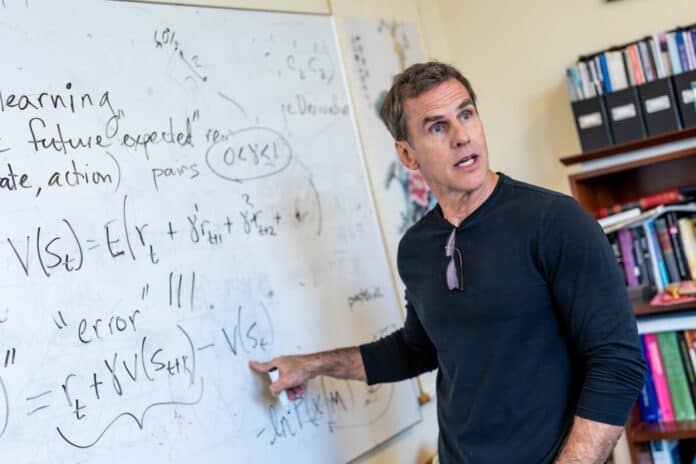When Read Montague addresses the University of Pennsylvania’s Mahoney Institute for Neurosciences on Oct. 29, he will describe how he and collaborators have overcome one of neuroscience’s most persistent barriers — the inability to observe human neurochemistry as it unfolds in real time.
And they’ve gone even further, linking those chemical signals to perception and behavior.
In his Louis B. Flexner Lecture, Montague, director of the Center for Human Neuroscience Research at the Fralin Biomedical Research Institute at VTC, will share how his group’s pioneering technology measures the release of dopamine, serotonin, and other neurochemicals in the living human brain — revealing how these neuromodulators shape perception, motivation, and decision-making.
His talk, “Dynamic tracking of neuromodulators during active perception-and-action in humans,” highlights a new era in human neuroscience — one where scientists can move beyond speculation and observe the chemical signatures of thought as they happen.
“This work opens a new window into the brain’s chemical dialogue,” Montague said. “By capturing these neurochemical changes second by second, we can start to connect molecular signaling to behavior in ways that were impossible before.”
The discovery represents the kind of bold, cross-disciplinary neuroscience that Louis B. Flexner envisioned when he established Penn’s first brain research institute more than 70 years ago. One of the nation’s first organized centers for brain research, the institute laid the groundwork for modern interdisciplinary approaches to studying the brain, 15 years before the U.S. Society for Neuroscience was created.
“Louis B. Flexner was a major scientific figure, who did pioneering work in neurochemistry and neurophysiology. He understood that neuroscience research is multidisciplinary, and in 1953 he organized what would become the Mahoney Institute for Neurosciences at the University of Pennsylvania,” said John Dani, chair of the Department of Neuroscience and director of the Mahoney Institute for Neurosciences at Penn. “Read Montague exemplifies the creativity and forward thinking of Flexner. Dr. Montague’s contributions to our understanding of decision-making and dopamine’s diverse organizing roles in the brain have been varied and have had profound impact on the direction of neuroscience research now and into the future,”
Montague’s research integrates computational modeling, human neuroimaging, and in-vivo neurochemical measurement to explore the biological foundations of decision-making and social behavior.
His work has appeared in Nature, Science, Neuron, and Nature Human Behavior, and has been featured in The New York Times, National Geographic, and Scientific American.
“This invited presentation reflects the national recognition of Read Montague’s groundbreaking contributions to neuroscience,” said Michael Friedlander, executive director of the Fralin Biomedical Research Institute at VTC and Virginia Tech’s vice president for health sciences and technology. “His work exemplifies the innovative, interdisciplinary science that defines Virginia Tech’s growing leadership in the brain sciences.”
Montague is also a professor of physics in the College of Science.
The Flexner Lecture is among the Penn’s most distinguished scientific events and and annually celebrates the enduring influence of Louis B. Flexner’s vision for integrative, interdisciplinary brain research.
By John Pastor


